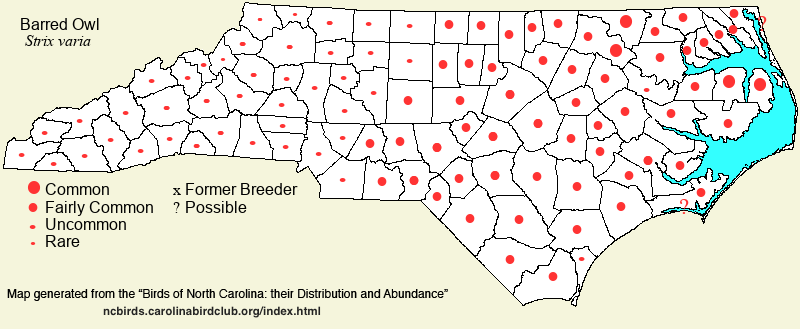 |  |
|
Barred Owl - Strix varia STRIGIDAE Members: | Search Common: Search Scientific: |
|
|
|||||||
| General Comments | This is the "swamp owl", being the nocturnal counterpart of the Red-shouldered Hawk; both nest and forage primarily in wetlands such as around beaver ponds and in open swamps, bottomlands, and nearby marshes. Unlike other owls, Barred Owls frequently call during the middle of the day; however, they forage at night or in twilight and are not diurnal foragers. Barred Owls do not appear to be declining, and they may well be slightly increasing, as beaver ponds are becoming more frequent. Barred Owls, as well as Red-shouldered Hawks, are also beginning to nest in wooded suburban areas, seemingly unthinkable a few decades ago. The species occurs essentially statewide but is relatively scarce in the mountains. | ||||||
| Breeding Status | Breeder | ||||||
| NC BRC List | Definitive | ||||||
| State Status | |||||||
| U.S. Status | |||||||
| State Rank | S5 | ||||||
| Global Rank | G5 | ||||||
| Coastal Plain | Permanent resident, apparently non-migratory. Fairly common over the province, except absent on most barrier islands. Can be common in some of the larger bottomlands/swamps, such as along parts of the Roanoke River floodplain. Peak counts: ? | ||||||
| Piedmont | Permanent resident, non-migratory. Fairly common in suitable floodplains, but uncommon in areas where there are not extensive floodplains. More numerous in the eastern Piedmont than in the foothills. Peak counts: ? | ||||||
| Mountains | Permanent resident, non-migratory. Uncommon in most areas, but locally fairly common, and it even occurs regularly at high elevations (to 6,600 feet). At these high elevations, it is one of two species of owl (the other being Northern Saw-whet) that nests in spruce-fir stands -- quite remarkable for a species generally thought of as a bottomland/swamp species downstate (where it avoids conifers). Peak counts: ? | ||||||
| Finding Tips |
To hear a Barred Owl, be at a road crossing through a bottomland or swamp. They normally call without provocation from a tape or human voice, but they do respond to both. Sometimes you can see one during the day while walking though a bottomland. They normally are hard to spotlight at night, and most birds do not come all the way to a tape or human voice.
*** | ||||||
| Attribution | LeGrand[2023-03-22], LeGrand[2021-08-04], LeGrand[2012-07-11] | ||||||
| NC Map Map depicts all counties with a report (transient or resident) for the species. | Click on county for list of all known species. |
| NC Breeding Season Map Map depicts assumed breeding season abundance for the species. |  |